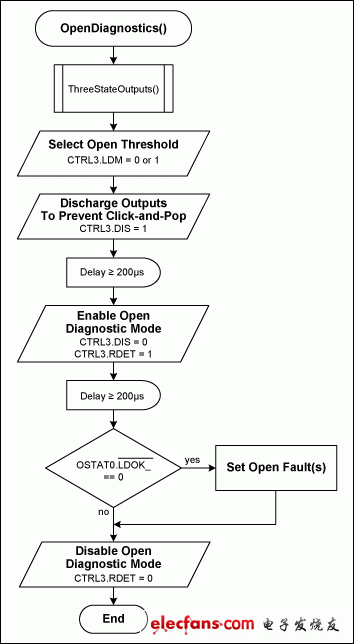Diagnosing Automotive Faults with Class D Audio Amplifiers(5)
Open Load Detection
This diagnostic detects an open between OUT_+ and OUT_- of > 70Ω or > 200Ω, depending on the value of the CTRL.LDM (load detect threshold) bit.
To detect open loads, three-state the outputs through I²C and discharge the output capacitors by setting the CTRL3.DIS (discharge) bit to 1. Run the open-load diagnostic test by setting CTRL3.RDET (open-load diagnostic enable) to 1. During the diagnostic, all low-side FETs on negative outputs (OUT_-) are turned on while all other FETs are turned off. The device sources a 2mA current from OUT_+ to OUT_-. If a load is not present, OUT_+ swings high and its relatively high VOUT_+ is interpreted as an open output. Results of the diagnostic are reported in the OSTAT0./LDOK[3:0] (load OK indicator) bits.
Step-by-Step Procedure (Figure 6)
- The outputs must be in three-state mode with the charge pump active (CTRL2.STBY = 0). If starting from MUTE or PLAY mode, follow the normal shutdown procedure to prevent click-and-pop.
- Set CTRL3.LDM based on application requirements.
- Discharge the outputs to ground by setting CTRL3.DIS = 1 to prevent click-and-pop during diagnostics.
- Wait at least 200µs.
- Enable the open-load diagnostic by setting CTRL3.RDET = 1 and CTRL3.DIS = 0.
- Wait at least 200µs.
- Read OSTAT0.LDOK[3:0] for results.
- Disable the open-load diagnostic by setting CTRL3.RDET = 0.

Figure 6. Open-load diagnostic procedure.
- 第 1 页:Diagnosing Automotive Faults with Class D Audio Amplifiers(1)
- 第 2 页:Three-State Procedure#
- 第 3 页:Load Diagnostics#
- 第 4 页:Short-to-Ground Diagnostic Procedure#
- 第 5 页:Open Load Detection#
- 第 6 页:Shorted Load/Resistance Measurement Detection#
- 第 7 页:Tweeter Detection#
- 第 8 页:Continuous Diagnostics#
本文导航
非常好我支持^.^
(0) 0%
不好我反对
(0) 0%
相关阅读:
- [新品快讯] 新唐科技推出emPowerAudio系列ISD810X音频功放 2011-03-22
- [电子动态] Wolfson推出高传真音讯(HD Audio)新产品线 为PC和NB掀 2011-01-27
- [厂商新闻] 欧胜面向电脑和笔记本电脑推出高清晰度音频( 2011-01-09
- [新品快讯] 欧胜微电子推出WM8958音频中心(Audio Hub)解决 2010-11-08
- [模拟威廉希尔官方网站 ] High-efficiency Class D audio 2010-09-22
- [LED电路] 9个LED组成的音频电平表电路, Audio VU mete 2010-03-28
- [模拟威廉希尔官方网站 ] TV audio amplifiers—thermal te 2010-03-03
- [新品快讯] ADI推出Audio Processor全系列提供多组的DA 2010-01-25
( 发表人:爱电路 )
